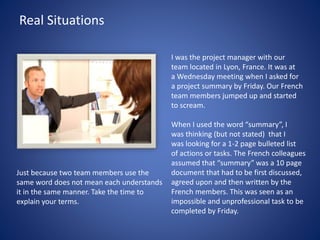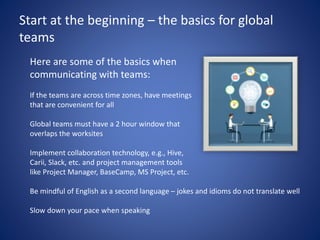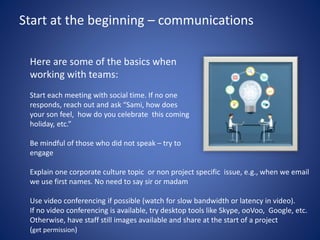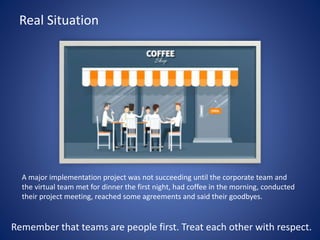Teams and Teamwork
- 1. Presented by SoftAssist, 2016
- 2. This brief presentation is about teams – those within a company, those that are composed of people inside and external to the company and those that are mixed and global. Each team has a unique composition but there are some shared commonalities and actions that can make better performing teams. References: How to Manage Remote Direct Reports, Rebecca Knight, February 10, 2015, Harvard Business Review Leading Teams, Tsedel Neeley, October 25, 2015, Global Teams That Work 10 Essential Tips to Managing Remote Employees, Jason Evanish, Lighthouse Blog Getting Virtual Teams Right, Keith Ferrazzi, website viewed, May, 18, 2016, Leading Teams 5 Basic Needs of Virtual Workforces, Randy Reyess, March 17, 2015, Harvard Business Review
- 3. Teams are teams – the people are unique Big picture things to remember: Global teams have their own culture, sense of identity, means of communications, styles, personalities, time zones, technology latency, languages, holidays, protocols and much more. Internal teams may share a culture and are more aware of specific cultural norms that are part of the corporate environment but there remain differences. Know the people and their personalities, their intent and purpose for being on the team, their role in corporate memory, their specific skills for having been selected, etc. Internal, global and mixed teams are each unique.
- 4. Real Situations I was the project manager with our team located in Lyon, France. It was at a Wednesday meeting when I asked for a project summary by Friday. Our French team members jumped up and started to scream. When I used the word “summary”, I was thinking (but not stated) that I was looking for a 1-2 page bulleted list of actions or tasks. The French colleagues assumed that “summary” was a 10 page document that had to be first discussed, agreed upon and then written by the French members. This was seen as an impossible and unprofessional task to be completed by Friday. Just because two team members use the same word does not mean each understands it in the same manner. Take the time to explain your terms.
- 5. Start at the beginning – the basics for global teams Here are some of the basics when communicating with teams: If the teams are across time zones, have meetings that are convenient for all Global teams must have a 2 hour window that overlaps the worksites Implement collaboration technology, e.g., Hive, Carii, Slack, etc. and project management tools like Project Manager, BaseCamp, MS Project, etc. Be mindful of English as a second language – jokes and idioms do not translate well Slow down your pace when speaking
- 6. Start at the beginning – communications Here are some of the basics when working with teams: Start each meeting with social time. If no one responds, reach out and ask “Sami, how does your son feel, how do you celebrate this coming holiday, etc.” Be mindful of those who did not speak – try to engage Explain one corporate culture topic or non project specific issue, e.g., when we email we use first names. No need to say sir or madam Use video conferencing if possible (watch for slow bandwidth or latency in video). If no video conferencing is available, try desktop tools like Skype, ooVoo, Google, etc. Otherwise, have staff still images available and share at the start of a project (get permission)
- 7. Real Situations The written training requirement went out to the team and the project owner. This was simple software simulation training. Each software field needed a blue box that highlighted each of the fields being discussed in the narration. Sounded simple but the team was met with great disappointment. The color blue that was used was incorrect, the length and height of the blue box did not tightly surround the field and the highlight did not last the proper amount of time. Use visuals that best define what is expected. Limit the unexpected through ongoing communications.
- 8. Start at the beginning – project basics Here are some of the basics when working with teams: Set expectations, roles, responsibilities, protocols, and accountabilities during the first meeting State that the rules are the same for local and remote team members Meet consistently, no last minute cancellations Stay in regular contact outside of the formal meeting. Create opportunities for “spontaneous chats” Nurture comfort, familiarity and trust. Be mindful of any cultural differences. Read, Culture and Organizations, Geert Hofstede (or similar) as a start Meet face to face when possible
- 9. Real Situations The offshore project team was behind by 2 days and the reason was not clearly communicated to the corporate team leader. The other team members did not speak up (cultural preference). It turned out that one of the developers had to take her mother to the hospital, stay overnight and then return her home in another providence. Understanding the situation, the project plan was adjusted, the project got back on track and the entire team was more relaxed. Follow up notes from the PM on the mother’s condition helped to bond the team even more. Teams are composed of people living their lives and performing normal functions each day. Get to know the team and share as much as is practical and comfortable.
- 10. Problems to Face Here are a few problems that might arise within teams: “I thought you meant…” Define , clarify and verify Back channels – people talking outside of the meeting to foster their own agenda Sabotage – misdirecting the agenda or goals, not cc’ing every team member, starting hearsay, intentionally not talking or withholding information Controlling the actions – not supporting the team manager, talking more than others or as needed, overruling or overwhelming a team member, intentional embarrassment Missing deadlines, late submission, exhibiting poor behavior, acting bored or non-compliant or generally un-cooperative
- 11. Remember Praise the team, acknowledge their support and spread the word.
- 12. Real Situation A major implementation project was not succeeding until the corporate team and the virtual team met for dinner the first night, had coffee in the morning, conducted their project meeting, reached some agreements and said their goodbyes. Remember that teams are people first. Treat each other with respect.
- 13. Thank you Give us a call if we can help you in your next training project or send us your team training situation. We love the challenge and are happy to chat. Dave Goodman SoftAssist, Inc. 700 American Ave. Suite 205 King of Prussia, Pa. 19406 1.610.265.8484 dgood@softassist.com SoftAssist designs, develops and implements classroom, online, mobile and gaming solutions.












